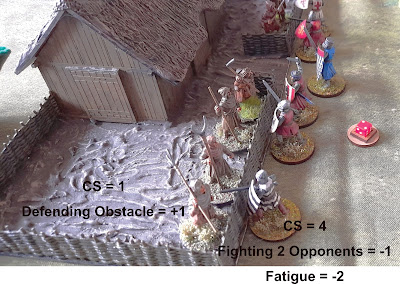Over the long and dreary winter months, I have continued to work on my 12th century campaign, King Henry's War. When I first started out on this little venture, I found and downloaded the skirmish rule set Knyght, Pyke and Sworde from Nordic Weasel Games, to use in the table top battles that would take place between the devious Bishop of Durham and those supporting the beleaguered King Henry.
Although I really enjoyed the rules, there were things about them that left me feeling as though the battles I fought just didn't quite feel historically right, particularly the melee combat, which was just too random in its outcomes. For an armoured knight to be bested by a lowly peasant, should be a rare event to be applauded and recorded in the annals, but, in the early games of the campaign, this was happening more often than not!
This was the reason why I started thinking about adapting the rules and giving the random die roll much less weight in the outcome of the combat. In my adapted version of combat, the outcome is determined by the figure's combat skill, a random factor, which is also related to the combat skill, and a small number of situational factors, such as the defender's position and the combatants' level of fatigue.
In the example above, a group of Armed Peasants are in melee with a group of Men-at-Arms! The fight takes place in the open, so there are no Situational Modifiers and neither side has gained any Fatigue. The Peasants have a Combat Skill of 1, but the Men-at-Arms lifelong combat training gives them a Combat Skill of 4. In ten sample combats between the two figures in the foreground, the Man-at-Arms was victorious in all ten! Using the un-adapted combat rules and the same dice rolls, the Peasants would have won 5 of the combats, 3 of them would have been tied and the Man-at-Arms would have won the remaining 2! Historically somewhat unlikely I think!
10 victories out of 10 may seem a little unfair on the poor Peasants but, fighting a group of Men-at-Arms out in the open was doomed to failure when you compare the training, weapons, armour and sheer aggression of the two opposing groups. However, in the situation above, the Peasants have applied a little grey matter and positioned themselves behind a very handy obstacle. The Men-at-Arms have been busy prior to this fight and gained themselves 2 Fatigue Points and this one has managed to get himself in a position where he is facing two opponents. The result of these factors is that the two Peasants outscore their opponent by 2 to 1 before the Dice Roll Modifier is rolled. Again, ten sample rolls were rolled, but this time, the Man-at-Arms was victorious in only two of them, while the two Peasants won three and the remaining five were tied! In fact, because the Men-at-Arms have Fatigue and the Peasants don't, means that the Man-at-Arms would lose the combat and be pushed back and possibly suffer melee damage!
A final test run with the amended combat system pitched the group of Men-at-Arms against a more well matched opponent; a group of seasoned spearmen. Out of all the combats, the Men-at-Arms won 60%, the spearmen 20% and 20% were tied, which seems pretty much what you might expect, even though the dice were rolling quite poorly for the spearmen. Just to complete my little experiment, I fought the whole engagement between the spearmen and the Men-at-Arms as they appear in the photograph. Only one of spearmen defeated his opponent (the axe wielding leader of the group second from the bottom) and he inflicted a single wound on his opponent. The other four spearmen engaged were all pushed back without injuries being inflicted, which, considering the large shields and padded gambesons seems a fairly realistic result. Those results would have gained both groups a point of Fatigue to be carried over into the next activation. If the Men-at-Arms continued to push the spearmen back then, eventually, Fatigue, rather than injuries, would cause them them to break. As an outcome, that seems to me to fit with descriptions of medieval battle being an almighty scrum-like push and shove, rather then every stroke of sword or thrust of spear resulting in a bloody wound.
So, now that I'm a little happier that my amended melee system gives a reasonably honest, if somewhat dour portrayal of a skirmish, as it may have been fought out in the later 12th century, it's back to the table top in a couple of days to fight out the next instalment of the ongoing conflict between the Bishop of Durham's forces and those loyal to good King Henry.






No comments:
Post a Comment